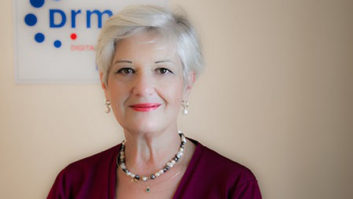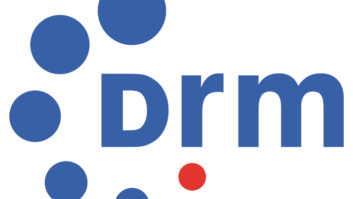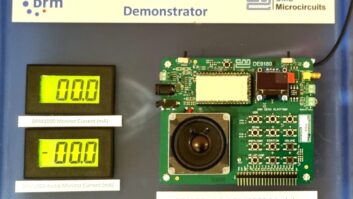This is the second in a two-part series on the development of the Digital Radio Mondiale technology. Part 1, in the Oct. 22 issue, explored DRM’s history and began to look at how the technology compares to Eureka-147 and HD Radio.
For DRM, the situation is slightly more complex, as a reduced-quality simulcast mode is available within the system specification. However the DRM consortium prioritizes stand-alone operations, which means the DRM all-digital transmissions to date have been almost exclusively on separate frequencies from any analog outputs of the same program material.
Thus, the DRM approach is similar to that of Eureka-147, an all-digital signal. The reasoning is that because the available bandwidth is so limited in ITU Regions 1 and 3, the DRM simulcast mode cannot offer full audio quality and interference may still be caused to existing AM services.
(click thumbnail)The DRM signal path. DRM’s Peter Jackson states: “While this does not show a transmitter, there would usually be an exciter after the modulator, providing two options for driving the transmitter: linear and non-linear. For a linear transmitter the DRM COFDM composite signal from the exciter is applied to the transmitter input, amplified and then applied to the antenna. In the case of a non-linear transmitter the exciter provides a DRM signal phase component, which replaces the usual transmitter input from the carrier frequency synthesizer, and a DRM signal amplitude component, which goes into the transmitter modulator where the normal audio would go in. An amount of delay is applied to the amplitude component to ensure that it is time co-incident with the phase signal at the modulator and the resultant DRM COFDM signal is then produced at the transmitter output, which is coupled to the antenna.”
For Eureka-147, there is no simulcast mode, as the system is operated on entirely separate frequencies.
DRM allocations therefore can be made within the existing AM broadcast bands, but on separate channels from those used for any existing AM analog version of the same service. It is possible to operate all-digital DRM transmissions on other frequencies below 30 MHz, where space and regulations allow.
Current planning rules simply require that, to avoid interference to nearby analog services, the effective radiated power level of any DRM service be 7 dB down from the maximum that would be allowed for an analog service transmitting from the same location and on the same frequency.
From an engineering perspective, the only other area of concern is antenna systems. Just as with HD Radio, for DRM transmissions it is essential to maintain phase accuracy and to avoid incidental phase products being created.
Data capabilities
The DRM system can operate within current AM broadcast band plans, which are predominantly based on signals having channel spacing of 9 or 10 kHz. Stations transmitting using DRM also may use narrower bandwidths (4.5 or 5 kHz), inevitably with lower data carrying capacity.
The system specification also includes the ability to use multiple channel implementations (for example, dual-channel allocations within bandwidths of 18 or 20 kHz). Such wider — bandwidth modes have a greater data carrying capacity and could be used to carry high — quality stereo audio and enhanced data features.
In a channel of 9 or 10 kHz, approximately 200 carriers constitute the DRM OFDM signal. However, within the DRM specification, the precise modulation scheme used can be varied to suit the particular type of transmission being undertaken (local broadcasting, international long — distance or multi — hop sky-wave etc.) and the type of programming being broadcast.
The mode used defines the amount of error correction employed in the transmissions and hence the amount of carrying capacity left for program material. The worse the transmission path, the greater the amount of error correction used and the smaller the remaining available program-carrying capacity.
A DRM signal contains an internal multiplex comprising three distinct parts: the Main Service Channel, Fast Access Channel and the Service Description Channel. The function and characteristics of these parts of a DRM signal are described in an accompanying chart.
The best available program audio quality is achieved using MPEG-4 Advanced Audio Coding with Spectral Band Replication, otherwise known as MPEG-4 aacPlus. After the recent changes in the coding system used by the Ibiquity HD Radio system, the two systems are now even more similar to each other.
Coding Technologies says SBR, which both DRM and HD Radio use, is an efficient method for recreating high — frequency audio components from a Musical Instrument Digital Interface file — like low-bit-rate data stream (~2 kbps).
At low bit rates, most transform coding systems (such as MPEG-4 aacPlus) perform better if the bandwidth of the program material being transmitted is reduced. The principle is that, by reducing the audio bandwidth, data bits can be more efficiently used because the number of frequency analysis bands needed is reduced.
By using SBR to digitize and subsequently recreate audio frequencies above around 7 kHz, the performance of the AAC coding can be made more efficient, as it only needs to handle frequencies below this point. The resultant audio has good subjective performance in the most critical part of the audio spectrum (500 Hz to 6 kHz) while retaining an audio bandwidth that extends up to 15 kHz (all in a data rate of around 20 to 25 kbps).
Euro digital radio
In essence, therefore, mainstream implementations of DRM are similar to AM HD Radio with the analog system component removed. After the recent change of codecs by HD Radio, although some differences remain, the similarities extend to the coding algorithm used as well.

While this development may have reduced the unique intellectual property rights associated with the HD Radio system, it should make dual-standard HD Radio and DRM receivers easier and, because of potential economies of scale, cheaper to produce. Despite greater technical differences between them, the World DAB Forum and the DRM consortium recently announced an alliance to jointly promote the DRM and Eureka-147 systems.
Several receiver manufacturers support the move. Fenno de Boer, group marketing manager business developments for Sony Personal Audio Europe, stated in September, “We are actively supporting the spread of digital radio broadcasting in Europe and through our partnership with members of DAB and DRM we believe we can expand the use of digital radio in Europe.”
Although DRM is the younger standard, some broadcasters are investing heavily. Peter Gordon of transmission firm VT Merlin, speaking at the launch of new DRM facilities in the United Kingdom, said the company has invested approximately $828,000 in its new 200 kW MF DRM facilities. He said these facilities will “be used to encourage broadcasters to begin DRM pilots,” adding that since the official launch of the standard in June, “there had already been a surge of interest from other broadcasters.”
Listeners are concerned about one thing above all else: the ability to receive the programs they want easily and reliably. Digital radios that receive all systems “transparently” as far as the listener is concerned wherever he or she happens to be should help drive the take-up of digital radio around the world.












